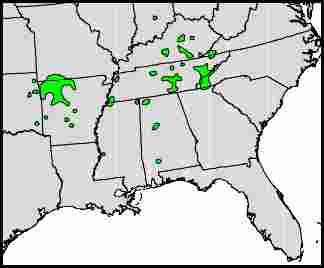American Yellowwood
(Cladrastis kentukea)
The American Yellowwood can put on one of the most spectacular flowering displays of any tree species. The blossoms appear in late spring, when numerous wisteria-like foot-long flower clusters droop from the branches. The color is normally white, but can be pink. In either case, a mature tree in full bloom is a stunning sight. In recognition of its beauty, the species was given the prestigious Pennsylvania Horticultural Society Gold Award in 1994.
Unfortunately, many people have never seen the tree in bloom. The species is rare in the wild and seldom planted in yards. Also, most specimens don't flower profusely every year, but only at two to four year intervals.
The blossoms develop into bean-like pods that can hang on the branches into winter. Leaves are pinnately compound, usually with about seven leaflets. They turn a clear yellow, or sometimes gold-orange, before dropping in autumn. Smooth gray bark and a rounded form give the tree a handsome look in winter.
Yellowwood can make an excellent mid-size lawn tree. It deep taproot gives it drought resistance and allows other plants to grow beneath it. It also tolerates alkaline soils. Its main drawback is that it is rather slow growing, and often doesn't begin to bloom until it is about ten years old. It also has brittle wood that can break in storms, so it shouldn't be planted near a house or other structure.
Sometimes a young yellowwood will begin to fork into several main branches just a few feet above the ground, and in such a case it might be desirable to prune it to a single trunk. But any pruning should only be done in fall or early winter, because the tree bleeds excessively if pruned at other times.
The species is found over a large geographic area, but only in small scattered populations. Some large individuals can be seen in the Great Smoky Mountains National Park, particularly along the Cove Hardwood Nature Trail. Cultivated specimens have proven to be hardy in Zone 4.
Other Information
Scientific Names: Cladrastis kentukea, Cladrastis lutea
Common Names: Yellowwood, Gopherwood, Vergilia
Plant Type: Mid-size deciduous tree
Height: 40 to 50 feet
Cultivation Zones: 4 - 8
Native Habitat: Valleys or mountain slopes in hardwood forests.
Native Range: Scattered populations mostly in the upper South and in the Ozark region of Arkansas. See distribution map below.
Distribution Map

Range Map Source: U.S. Forest Service. (See General Note C)
Conservation Status: NatureServe lists Cladrastis kentukea as Critically Imperiled in Illinois, South Carolina, and Louisiana; Imperiled in Indiana and Mississippi; Imperiled or Vulnerable in Oklahoma and North Carolina; Vulnerable in Alabama, Georgia, and Missouri; and possibly Vulnerable in Kentucky. Officially the species is classified as Endangered by Illinois and Threatened by Indiana.
Cultivation: Yellowwood does best in moist neutral soils with good drainage. It tolerates partial shade but grows faster and blooms better in sun. Because of the long taproot, big specimens can be difficult to transplant. Keep young trees well-watered and don't over-fertilize. Go to Cultivation and Seeds for more information.
Related Species: There are no other members of this genus native to the U.S., but a few are found in Asia. The plant is part of the Legume family and is therefore distantly related to Locusts and Redbuds.
Plant Sources: Possible suppliers of this plant include Forest Farm, Elk Mountain Nursery, Woodlanders, GroWild, and Nearly Native Nursery. Pink-flowering forms ("rosea" and "Perkins Pink") are sometimes available. For links to the mentioned suppliers, go to Sources of Plants.
|

